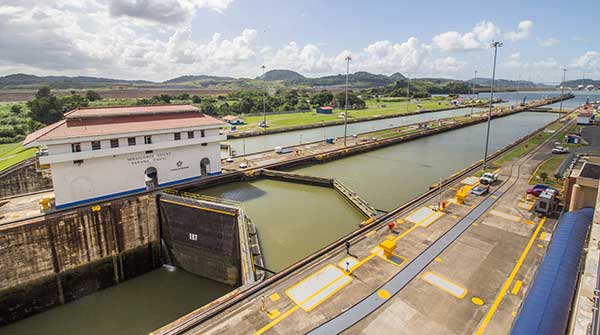The Panama Canal is drying up, but because of our sluggish LNG development, Canada is unprepared to take advantage of the disruption
 There’s a very serious problem occurring a few thousand miles to the south of us, one that Canada could have taken tremendous advantage of if only we had built and completed some liquified natural gas (LNG) terminals by now.
There’s a very serious problem occurring a few thousand miles to the south of us, one that Canada could have taken tremendous advantage of if only we had built and completed some liquified natural gas (LNG) terminals by now.
The Panama Canal, one of the wonders of the modern world that utterly changed trade and geopolitics, is drying up.
Typically accommodating about 36 ships daily, the canal has recently reduced that number to 24. By Feb. 1, this is expected to further decrease to 18. Furthermore, larger vessels transiting the canal must reduce their cargo load to avoid grounding.
That’s because the canal uses fresh water, captured by dams and primarily sourced from Gatun Lake. That fresh water is collected from ample rains. Each time a ship passes through the canal, the water used to operate the locks is flushed into the ocean. Despite an innovative water recovery system introduced with the expanded third set of locks, these larger ships consume substantial amounts of water. Unfortunately, the Canal Authority has reported the lowest rainfall in 73 years, dating back to 1950.
So when you add up the additional, much larger locks with a local drought, the canal is rapidly falling into crisis. And the world is starting to take notice.
As they should, since soon half of all ships that usually use the canal will be turned away.
No one depends on the canal more than the Americans. They built it, after all, for a reason. One of the biggest reasons is it allows for quick access for Gulf Coast ports to Pacific markets. This – in addition to their proximity to gas production – was a compelling reason why constructing several large LNG terminals made sense.
However, a significant part of this advantage just got thrown out the window. With ship transit numbers halved, the ability of U.S. LNG shipments to access Pacific markets has been drastically curtailed. The alternative for these shipments is to travel around South America’s treacherous Cape Horn, an option no one desires. Alternatively, they would have to cross the Atlantic, Mediterranean, Red Sea, Indian Ocean, and the Straits of Malacca to reach East Asian markets.
The net effect will be that some cargoes from the Gulf Coast destined for Asia will have to go much further to deliver their product. That means fewer cargoes per ship per year. It’ll tighten up ship availability, and likely put pressure on LNG prices.
Canada could have been ideally positioned to capitalize on this situation if it had moved swiftly to develop LNG terminals, especially on the West Coast. Locations like Kitimat, Prince Rupert, and others on the West Coast are much closer to China and Japan, without the concerns of a drying-up Panama Canal.
Small wonder, then, Conservative Leader Pierre Poilievre chose on Nov. 10 to post on his various social media channels, “Since Trudeau took office: 18 LNG terminals have been proposed. 0 have been completed.”
To be fair, LNG Canada, the largest proposal, is in the finishing stretch. In July, the company reported 85 percent completion. TC Energy recently reported the completion of the “golden weld” on the Coastal GasLink pipeline that will supply LNG Canada and presumably other facilities on the West Coast. Without this pipeline, which was massively delayed and over budget, no small thanks to pipeline protesters, LNG Canada would be useless.
Other projects are finally gaining traction – Woodfibre LNG at Squamish on the south coast, Ksi Lisims LNG right on the Alaska/BC border, and Cedar LNG, a floating LNG terminal adjacent to LNG Canada and served by Coastal GasLink.
Remember when the German chancellor came to Canada, seeking LNG, and was told by Prime Minister Justin Trudeau there was “no business case?” And then the Japanese prime minister was told something similar a few weeks later?
The Ukraine War has proven a business case for almost two years in the Atlantic basin. The Panama Canal reduction in service will soon prove it in the Pacific. What more do we need?
Canada should have built these projects years ago. We’d be securing markets and cashing in today.
“No business case”, indeed.
Brian Zinchuk is editor and owner of PipelineOnline.ca, and an occasional contributor to the Frontier Centre for Public Policy.
For interview requests, click here.
The opinions expressed by our columnists and contributors are theirs alone and do not inherently or expressly reflect the views of our publication.
© Troy Media
Troy Media is an editorial content provider to media outlets and its own hosted community news outlets across Canada.

